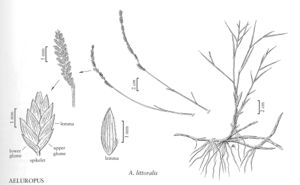Difference between revisions of "Aeluropus littoralis"
FNA>Volume Importer |
FNA>Volume Importer |
||
| Line 37: | Line 37: | ||
|publication year= | |publication year= | ||
|special status= | |special status= | ||
| − | |source xml=https://jpend@bitbucket.org/aafc-mbb/fna-data-curation.git/src/ | + | |source xml=https://jpend@bitbucket.org/aafc-mbb/fna-data-curation.git/src/f6b125a955440c0872999024f038d74684f65921/coarse_grained_fna_xml/V25/V25_37.xml |
|subfamily=Poaceae subfam. Chloridoideae | |subfamily=Poaceae subfam. Chloridoideae | ||
|tribe=Poaceae tribe Cynodonteae | |tribe=Poaceae tribe Cynodonteae | ||
Revision as of 20:24, 24 September 2019
Plants both rhizomatous and stoloniferous. Culms 9-25 cm, erect or decumbent. Sheaths strongly ridged, glabrous; blades 1.5-7 cm, adaxial surfaces glabrous, scabridulous, or sparsely hairy, strongly and closely ridged. Panicles 1-7 cm long, 4-10 mm wide, with 4-13 branches, each bearing 12 or more spikelets; lower branches usually not overlapping. Spikelets 3-4.5 mm, ovoid, with 6-9 florets. Glumes unequal, veins scabrous, margins glabrous or hairy; lower glumes 1-2.5 mm, 1-4-veined; upper glumes 1.5-3 mm, 3-6-veined; lemmas 1.5-4 mm, 9-11-veined, veins scabrous, margins glabrous or hairy, apices mucronate, mucros 0.1-0.3 mm; paleas hyaline, keels ciliolate; anthers 1-1.5 mm. Caryopses strongly compressed. 2n = 20.
Discussion
Aeluropus littoralis is native to Eurasia, where it grows in sandy, often saline habitats. It has been cultivated experimentally in Pima County, Arizona; it is not established in the Flora region.
Selected References
None.
